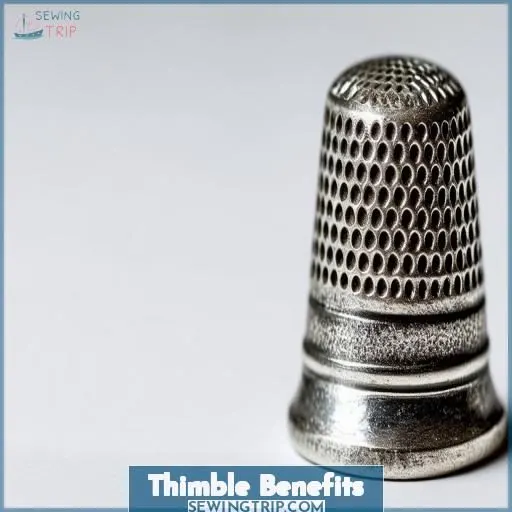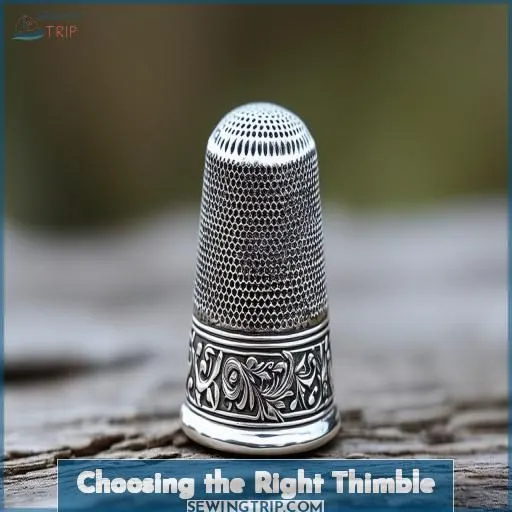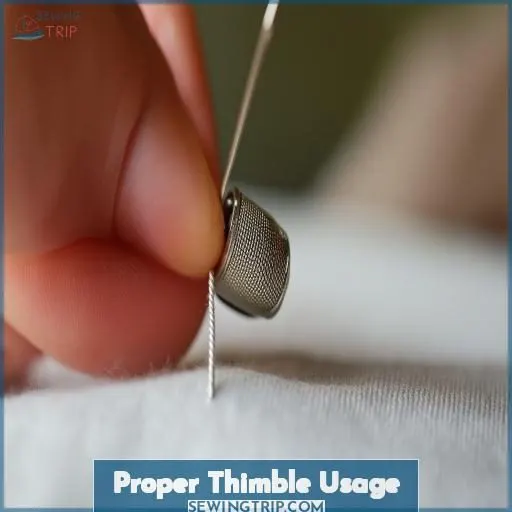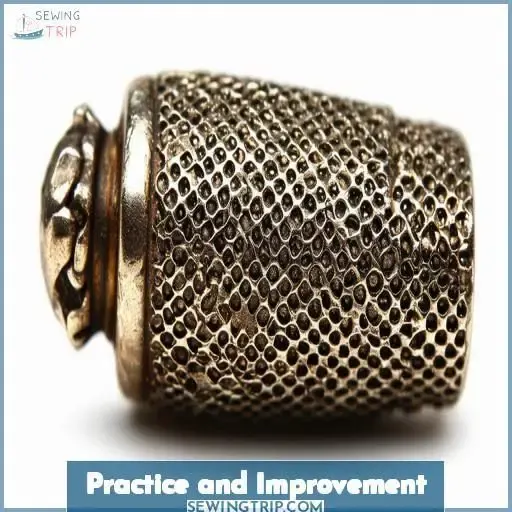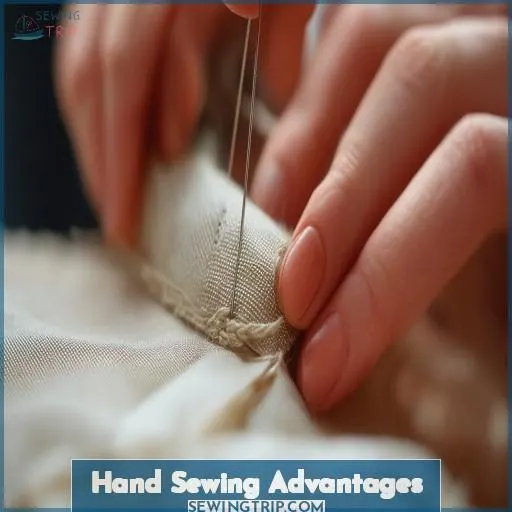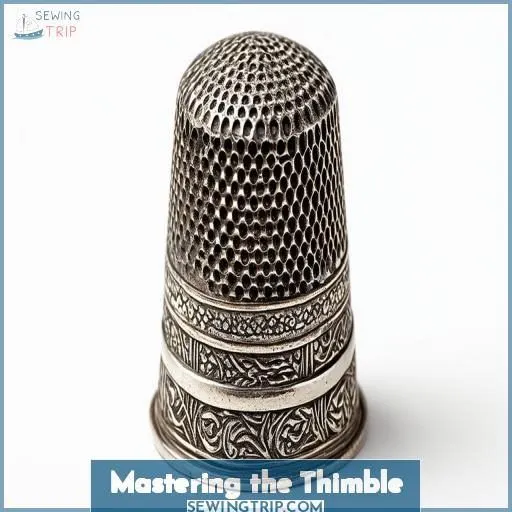This site is supported by our readers. We may earn a commission, at no cost to you, if you purchase through links.
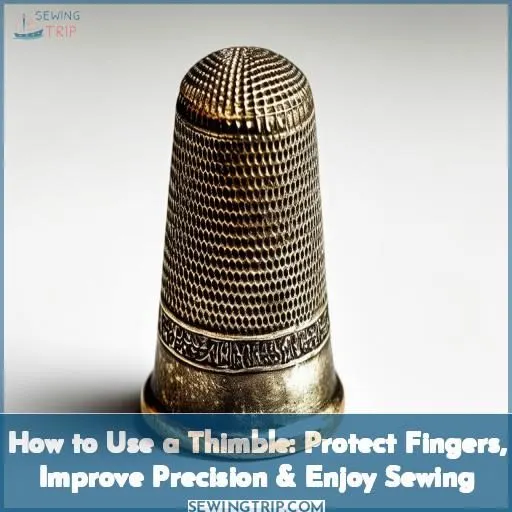 You’ll reveal the secrets of precise, effortless sewing by mastering the thimble. This timeless tool shields your fingers and enhances dexterity.
You’ll reveal the secrets of precise, effortless sewing by mastering the thimble. This timeless tool shields your fingers and enhances dexterity.
Start by choosing the right material, size, and fit for comfort. When using a thimble, hold the needle between your thumb and index finger, with the thimble on your middle finger.
Keep your wrist turned so the needle stays perpendicular, and push the eye with the thimble for secure insertion. Stitch in the needle’s direction while maintaining tension.
With dedicated practice and patience, you’ll gain skill and enjoy the advantages of intricate, durable hand sewing.
But this is just the beginning – keep exploring to reveal the true potential of thimble mastery.
Table Of Contents
Key Takeaways
- You’ll conquer the needle’s sharp jabs like a sewing superhero once you’ve mastered the humble thimble’s protective powers. Say goodbye to pricked fingers and hello to smooth sailing!
- Precision is where the thimble truly shines. With this nifty tool guiding your needle, you’ll stitch like a pro, creating garments that look like they were crafted by fairies themselves.
- Don’t settle for just any old thimble. Finding the perfect fit and material is key to comfort and sewing longevity. Treat your digits to a thimble that feels like a cozy extension of your hand.
- Rome wasn’t built in a day, and neither is thimble mastery. Embrace the journey, savor the small victories, and soon enough, you’ll be whipping out embroidered masterpieces that would make grandma proud.
How to Use a Thimble?
To use a thimble, you slip it over the middle finger of your dominant hand and position the thimble against the side of your fingernail when pushing the needle through fabric. A thimble protects your finger from the sharp needle and provides better control for precision sewing.
Thimble Benefits
Using a thimble protects your finger pad from the sharp needle, preventing painful pricks and calluses. It also increases precision by allowing you to push the needle with your middle finger, resulting in neater stitches and improved garment quality.
Finger Protection
A thimble’s primary purpose is safeguarding your precious finger pads from painful pricks and pokes.
Made from sturdy materials like metal or leather, it acts as a shield against sharp needles during hand sewing. Ensuring a proper sizing guarantees a snug yet comfortable fit, allowing precise needle positioning while keeping your digits shielded from harm.
Embrace finger safety with this humble sewing companion.
Precision Improvement
With a thimble, you’ll enhance your hand coordination, fostering finger agility for seamless needle control. Its strategic placement boosts dexterity, allowing precise stitch placement during garment construction. As your needle moves effortlessly, guided by the thimble’s protection, you’ll witness your sewing precision soar, elevating your skills to new heights.
Sewing Enjoyment
Beyond protection and precision, using a thimble enhances your overall sewing experience. It allows you to:
- Find comfort in the material (e.g., leather’s softness) and style that suits your needs
- Express creativity through intricate stitches and embellishments
- Build confidence as your skills improve with consistent practice
- Embrace the tradition of hand sewing for a more enjoyable process
Choosing the Right Thimble
When choosing a thimble, consider the material – leather, metal, or plastic – based on your preferences for comfort and durability. Select a size and fit that stays securely on your middle finger without feeling too tight or loose, as a properly fitted thimble is essential for efficient sewing.
Material Considerations
When choosing a thimble, consider the material.
Leather thimbles offer excellent durability and a snug fit.
Metal ones provide ideal ergonomics and coolness.
Plastic thimbles are lightweight and affordable, though less durable.
Opt for materials that complement your sewing style and needs – durability for heavy projects or breathability for marathon sessions.
Don’t overlook aesthetics either; a thimble you enjoy using encourages consistent practice.
Size and Fit
Finding the right size and fit is essential for thimble comfort. Try on various sizes – too tight restricts movement; too loose causes slipping. The shape should conform to your middle finger without pinching. Different materials like metal or leather also affect fit, so experiment to find what feels best.
Traditional Vs. Specialty
While traditional thimbles work well, you may consider specialty options for specific needs:
- Flexible silicone thimbles conform to fingers comfortably
- Dimpled metal varieties grip needles securely
- Open-ring designs ease fabric manipulation
- Decorative styles add aesthetic flair
Evaluate thimble types based on material durability, finger comfort, and aesthetic preferences – especially if preserving traditional techniques matters.
Proper Thimble Usage
To use a thimble properly, hold the needle between your thumb and index finger, with the thimble on your middle finger to push the needle eye. Keep your wrist turned so the needle remains perpendicular to your index finger as you stitch in the direction of the needle.
Hand Position
To use a thimble comfortably, hold the needle between your thumb and index finger, with the thimble on your middle finger. Keep your wrist turned and the needle perpendicular to your index finger for an ergonomic grip. This positioning provides efficient control, reducing finger fatigue while ensuring thimble safety and precision.
Needle Handling
With your thimble on the middle finger, hold the needle between your thumb and index finger. Push the needle eye with the thimble for:
- Secure thumb position
- Precise needle insertion
- Controlled finger pressure
- Comfortable wrist rotation
Gripping the needle properly protects your fingertips while allowing smooth, controlled stitches.
Stitch Direction
You’ll stitch in the direction of the needle. Keep the fabric flat on a table and maintain tension with your non-thimble hand. Proper needle position and finger placement are key:
| Needle | Fabric |
|---|---|
| Perpendicular | Taut, but not overstretched |
| Grip strength | Ergonomic comfort |
| Smooth motion | Consistent stitch length |
Develop a fluid motion for excellent precision and control.
Practice and Improvement
Developing the skill of using a thimble requires dedicated practice and patience. Begin with simple stitches and gradually increase the complexity as you refine your technique over time.
Skill Development
Gaining thimble comfort and dexterity takes regular practice. Start slowly on simple projects, focusing on proper hand positioning and stitch control. As you build experience, explore thimble accessories like finger guards or embellished styles to enhance aesthetics. With patience and a mindset of gradual mastery, thimble maintenance will become second nature.
Patience and Persistence
You’ll need patience and persistence when learning thimble use. Skill refinement takes time – don’t get discouraged! The more you practice, the smoother it’ll become. Stick with it, and thimble sewing will feel natural. As the saying goes, "practice makes perfect" – persistence pays off when mastering this traditional technique.
Hand Sewing Advantages
You’ll find that hand sewing with a thimble allows you to achieve invisible, precise stitches that add unmatched durability and strength to your garments. The diligent control also enables intricate details and embellishments that elevate the quality of handmade clothing to new levels.
Stitch Quality
When using a thimble, you’ll create stitches that are beautifully precise and almost invisible. The right thimble material, fit, and style – whether traditional or specialty – lets your needle glide smoothly, delivering consistent, even stitches. With comfort and control, you’ll marvel at the fine workmanship a humble thimble enables.
Garment Durability
Hand sewing with a thimble increases garment durability. You’ll effortlessly apply even, reinforced stitches that withstand wear and tear. Quality materials like:
- Durable fabrics
- Sharp, sturdy needles
- Thick, strong threads
- Well-fitted thimbles
Create garments built to last through thimble sewing’s careful stitching. Your handmade pieces gain heirloom-quality construction.
Intricate Details
With hand sewing, you’ll reveal the artistry of intricate embellishments and decorative stitching. Embrace needlepoint’s delicate beauty, mastering embroidery techniques for heirloom treasures. Each stitch, lovingly placed by your hand, breathes life into garments—transforming fabric into handcrafted masterpieces. Unveil your creativity; let the thimble guide your needle’s dance.
Mastering the Thimble
As you refine your thimble technique, gradually increase the complexity of your projects to challenge your skills and push the boundaries of what you can achieve with hand sewing. Embrace traditional techniques alongside the thimble, allowing you to honor time-honored sewing methods while utilizing modern tools for maximum precision and efficiency.
Technique Refinement
After mastering the basics, you’ll refine your technique. Experiment with:
- Different thimble materials for maximized finger comfort
- Varying your grip for greater needle control
- Trying both traditional and specialty thimble styles/designs
- Holding the fabric taut for precise stitch placement
With practice, using a thimble will become second nature, enhancing your sewing abilities.
Project Complexity
Your thimble needs may evolve as you take on more complex sewing projects. Opt for a thimble size that provides adequate finger dexterity, and choose a material or shape that maximizes comfort during extended use. Don’t be afraid to experiment—you might find certain thimbles better suit intricate needlework versus heavy fabrics.
Traditional Techniques
As you master the thimble, explore traditional techniques that showcase its versatility. From hand-sewn quilts to delicate embroidery, the right thimble—whether metal, leather, or plastic—complements intricate stitches. Embrace thimble shapes and sizes optimized for specific needlework styles. Caring for your thimble preserves its legacy and connection to sewing’s rich history.
Frequently Asked Questions (FAQs)
How do you care for a leather thimble?
Leather thimbles need proper care to last. Clean them with a damp cloth and saddle soap, then condition with leather conditioner. Store in a cool, dry place away from sunlight to prevent drying or cracking. With a little TLC, your leather thimble will serve you well for years.
Whats the best thimble for sewing on thick materials?
You’re about to sew like a boss! For thick materials, grab a thimble crafted from tough metal or horn. These bad boys won’t crack under pressure, keeping your fingers safe and stitches on point.
Can thimbles be used for other crafts besides sewing?
Thimbles protect your fingers for crafts like embroidery, needlepoint, and leatherworking. They provide control when pushing through thick materials, allowing precise stitches and detail work.
Are there different thimble techniques for left-handed sewers?
Yes, left-handed sewers often use a thimble on their right middle finger. This placement allows better control and precision with the needle held in the left hand. Some also prefer a thimble with an open-ring design for improved dexterity.
When should a thimble be replaced for optimal use?
Imagine stitching away, only to prick your poor finger yet again – a thimble’s cry for retirement! Replace it when the metal wears thin, the leather frays, or its snug fit loosens. A fresh thimble means smoother sailing on your sewing adventures.
Conclusion
By diligently honing your thimble prowess, you’ll shield your digits from harm and unveil a world of intricate needlework. As you journey deeper into the art of how to use a thimble, precise stitches and durable creations await. Embrace patience, seek refinement, and let this timeless tool elevate your skills to extraordinary heights.

